Stimulus Control? That Sounds Complicated!
Hopefully I didn’t just frighten anyone away by the title of today’s blog, but don’t be afraid of the term, it really isn’t that complicated! A stimulus can be anything that we have a response to, which can be learned or not learned. The sound of the doorbell is a stimulus which has a specific meaning to it; we learn that the bell means that someone is at the door. In training, we refer to our cues as a discriminative stimulus because the cue is a stimulus that has been learned and has a specific meaning. My dogs have learned that my hand spinning in a clockwise motion means that they should spin. That hand motion only means spin to them because it is different than any of their other cues and they are able to discriminate it from other hand cues.
So where does the control part come in? Stimulus control means that the behavior that is asked for happens immediately and correctly. Remember Gary Wilkes from last week and “It’s a no no to say it twice twice” ? Well, that goes right along with this stuff. The author of the book, “Don’t Shoot the Dog” is a well-known marine mammal trainer and dog trainer by the name of Karen Pryor. In her book, she outlines for us her rules of stimulus control and they are recopied here from page 73 of her revised book:
- The behavior always occurs immediately upon presentation of the conditioned stimulus. (the dog sits when told to)
- The behavior never occurs in the absence of the stimulus. (during training the dog never sits spontaneously)
- The behavior never occurs in response to some other stimulus (if you say “lie down” the dog does not offer the sit instead)
- No other behavior occurs in response to this stimulus (when you say “sit” the dog does not respond by lying down or leaping up and licking your face)
In a nut shell, your dog should correctly perform what you ask the first time it is cued and not offer anything besides the correct behavior. I’ve included a video of me working with Buffy so you can see an example of stimulus control. Watch for my cues and how Buffy responds. And, if you’re interested in learning more about the science of training, make sure to check out Karen Pryor’s book! It’s easy to read and has valuable applications for training animals as well as everyday life situations.
Other Recent Blog POsts

Celebrating The Original Floofins’ Sweet 16
July 24, 2024
Emergency Planning for Your Home & Pet
July 18, 2024
Beyond the Blurry Phone Pic: Schedule Professional Pet Photos Instead
July 10, 2024
Keeping Chicago Pets Safe on the Fourth of July
July 1, 2024
Why Floofins & Co. Leads the Pack
June 26, 2024
